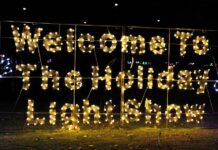The El Cajon Historical Society held its April meeting at the Sycuan Cultural Center and Museum. It was the perfect place for this gathering of historians as they received an intimate perspective of the history, present and future of the Kumeyaay Nation in this region. Beginning with the history of the Kumeyaay as a nation, we learned that the Center is located on a prehistoric site, the Village of Matamo. There are plans to rebuild the style of this village using the same handmade tools that the Kumeyaay used to build during this period of history.
The El Cajon Historical Society held its April meeting at the Sycuan Cultural Center and Museum. It was the perfect place for this gathering of historians as they received an intimate perspective of the history, present and future of the Kumeyaay Nation in this region. Beginning with the history of the Kumeyaay as a nation, we learned that the Center is located on a prehistoric site, the Village of Matamo. There are plans to rebuild the style of this village using the same handmade tools that the Kumeyaay used to build during this period of history.
This Center is utilized to show the commitment of the Sycuan Band of the Kumeyaay Nation to the preservation of its language, culture and traditions.
This is being accomplished in several other ways also. On site is the Kumeyaay Community College where in a partnership with Cuyamaca College, students can earn and associate’s degree in Kumeyaay Studies that is transferable to the University of California and California State University Systems. The program is open to high school students who will receive dual enrollment for high school and college credit. Associate degree requirements require classes in Ethnoecology, Kumeyaay History, Kumeyaay Arts and Culture and the Kumeyaay language. The language part of this curriculum is an ongoing effort in the Kumeyaay Nation to restore and revitalize its native tongue to the next generation, preserving its language along with its traditions and culture. Its non-credit classes include Kumeyaay foods, basketry, pottery and tools, learning how to use these skills as their ancestors.
In a trip to the museum on site, there are beautiful artifacts to look at and learn about the history and culture of the Kumeyaay people. A timeline across the wall demonstrates the longevity of the Nation with thousands of years of history.
The library archives at the Center are a remarkable collection is filled, mostly due to the donation of Dr. Florence Shipek. She worked closely with the Kumeyaay elders and other Southern Californian Native Nations. In their latter years between 80-years-old to 100 years plus, she accumulated a plethora of books, papers, and personal research that was all donated to the Sycuan Band after her passing in 2003 by her family. This donation became the base for the current Sycuan Archives & Library at Sycuan.
Eldonna Lay, El Cajon historian and curator of the Knox Museum said that Shipek was her mentor for many years.
“She was a famous anthropologist,” she said. “She was the one I called when I had any questions about Indians and that was even before we met. In her latter years I would go over and we would laugh and talk, but she always told me things that most people didn’t know.”
Lay said the Westerners, a highly prestigious group of men at the time were highly know for their books and Shipek was the blunt of many of their jokes. Women were not allowed in the group and considered not qualified to participate in the historical significance of their work.
“When they finally had to come around accept Florence it was a hard pill for them to swallow,” she said. “But she was the one that said that the Indians had been farming for thousands of years, and that one of the problems when the Spanish came is that their horses ate up all of their food. This was one of the reasons that the Indian attacks began occurring. She found that they were the first to build dams and corral the San Diego River water.”
Lay said Shipek was many years ahead of anyone and an exceptionally important person to the history of this region. “She was a no-nonsense woman. She battled the government. She herself drove the elderly up the coast to make sure they were registered as citizens so they would receive retirement insurance from the federal government. These people had nothing. They were living horrible lives and horrible conditions. She was there on that whole track and documented every piece of it,” said Lay.














